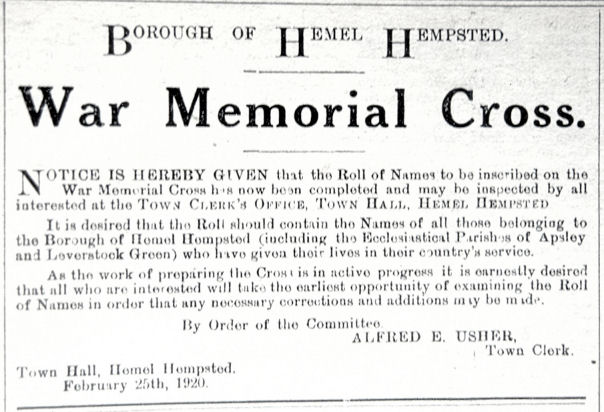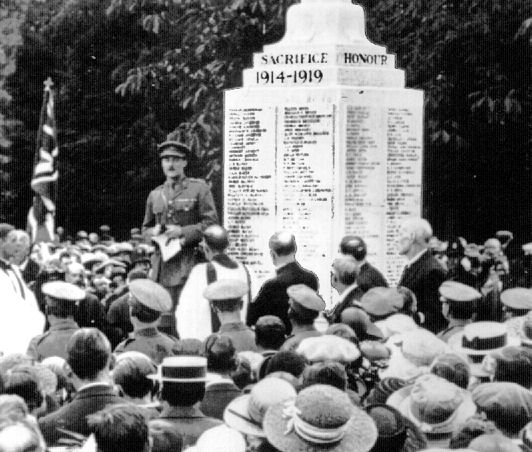|
|
Hemel Hempstead War Memorial |
|
|
When I was writing The London Gunners Come to Town in 1995 I was particularly interested in what happened to employees of Hemel Hempstead Borough Council, but was unable to find a list of employees who had died in the war in the Council's archives. To try and get round this difficulty I drafted a list of the names on the many different war memorials relating to Hemel Hempstead so that if I came across a name I could quickly check whether he was one of the citizens who had died. Click here to see the draft list (pdf) The memorials examined were:- St Maryís, Apsley; Boxmoor Roman Catholic Church; John Dickinson & Co., Apsley (employees from Apsley & Nash Mills); St Maryís, Hemel Hempstead; Holy Trinity, Leverstock Green; Marlowes Baptist Church; St Johnsís, Boxmoor; St Paulís, Hemel Hempstead; Town Memorial |
|||||
|
|
|||||
| The following text from The London Gunners Come to Town describes the way the names for the Hemel Hempstead War Memorial were gathered. | |||||
|
|||||
|
Remembering the Dead As soon as the fighting had finished, thoughts turned to the question as to the way in which the local dead should be remembered, and there were many arguments about the form any memorial should take. The nearby town of Tring was well prepared, and their war memorial was unveiled on Wednesday, 27th November, 1918, when The Gazette reported that out of over 900 men who had enlisted (about 20% of the population) 93 had given their life in the service of their country. Other war memorials which listed the names of the deceased were slower to appear. In Apsley a wartime army hut was erected in memory of those who had died. It was in Orchard Street and was opened on 227th September, 1919. Many of the churches erected memorials. One of the first was at St Paul's, where a chapel was dedicated on 2nd November, 1919, with tablets bearing the names of the heroes of the parish on either side of the altar. The service was conducted by the Rev. L. H. Boswall, and attended by the 2nd Boxmoor Girl Guides and a troop of Life Brigade Scouts. Just over a week later, on 11th November, the town celebrated the Armistice, as The Gazette records:
One of the major problems associated with the town memorial was in drawing up the list of those whose names should be remembered, as there was no suitable register of former inhabitants, and casualties, on which the list could be based. The Gazette had published details of casualties throughout the war, but in many cases it is not clear how strong the connection was with Hemel Hempstead, if any, and there is no evidence that these records were systematically used. In July, 1917 the Council prepared a form inviting the inhabitants of the town to record details of casualties and honours, but if any were returned they have not survived. What is clear is that on 12th July, 1919, The Gazette published a list of names, ranks and addresses of about 250 of the fallen to be engraved on the memorial. It points out that the final list will be in alphabetical order, without rank, and that it will therefore be impossible to enter missing names once the stone has been engraved. The "completed" roll was available for inspection at the Town Hall in February, 1920, to allow further opportunity for corrections and additions. Appeals such as this resulted in many more names being submitted as the stone was eventually carved with 387 names, and one must wonder how many were omitted in error. A typical "missing name" is that of A. E. Glover, of Boxmoor, who is mentioned in a list of casualties from the Hertfordshire Regiment, published in The Gazette on 4th November, 1916. The omission of those who died after the war from wounds or disease contracted while on active service was of more concern at the time. For instance 25 year old Arthur Nelson Carter, son of the waterworks engineer, George Carter, had been in the Royal Naval Air Squadron, and was invalided home from East Africa. He worked at the waterworks for a time before succumbing in February, 1920, to the disease he had caught in Africa. Eight months later 23 year old Sidney Russell George, son of Mr & Mrs George of Bury Road, died as a result of having been wounded three times, gassed twice and buried alive for three days while serving in the Bedfordshire Regiment. Driver Harry Wiseman, of Puller Road, died of illness brought on by active service, at about the same time. In June 1921 The Gazette reported the death of Private John Burns, who joined the Beds Regiment the day following the outbreak of war and who had returned to Hemel Hempstead a wreck ..... minus a leg, an eye and suffering from wounds to the face. After describing the funeral the paper concludes We wonder if it is not possible to include such names as Wiseman, Beckwith and now Burns on the memorial cross - what is the difference in their sacrifice! We wonder also that still more is not done for those who are similarly left to suffer from the vile effects of war service. |
|
||||
|
Notes
|
|||||
| February 2014 | Page Created |






